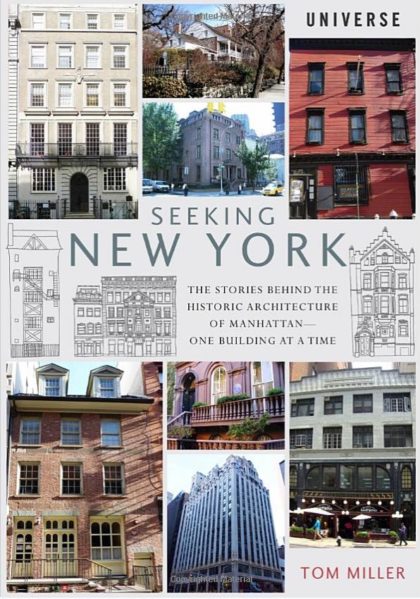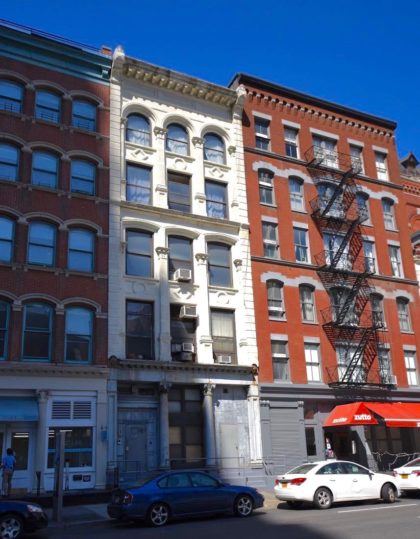The History of 75 Hudson
 Tom Miller, who writes about the history of Manhattan buildings at Daytonian in Manhattan, has allowed Tribeca Citizen to create a database of his Tribeca posts. If you enjoy these, and you will, then you should definitely check out his website, which also has write-ups about buildings all over the island. And don’t miss his book, Seeking New York: The Stories Behind the Historic Architecture of Manhattan—One Building at a Time.
Tom Miller, who writes about the history of Manhattan buildings at Daytonian in Manhattan, has allowed Tribeca Citizen to create a database of his Tribeca posts. If you enjoy these, and you will, then you should definitely check out his website, which also has write-ups about buildings all over the island. And don’t miss his book, Seeking New York: The Stories Behind the Historic Architecture of Manhattan—One Building at a Time.
··································
 John L. Hasbrouck came “of an old Huguenot family which was forced to leave France because of religious persecution,” according to The Sun. Born in Utica in 1810, he moved to New York City in 1860. Financially secure, he purchased an interest in Benjamin Van Schaick’s wholesale grocery operation. Just five years later he founded his own firm, John L. Hasbrouck & Co.
John L. Hasbrouck came “of an old Huguenot family which was forced to leave France because of religious persecution,” according to The Sun. Born in Utica in 1810, he moved to New York City in 1860. Financially secure, he purchased an interest in Benjamin Van Schaick’s wholesale grocery operation. Just five years later he founded his own firm, John L. Hasbrouck & Co.
John L. Hasbrouck & Co. was a departure from the grocery business. Originally a wine importing firm, it would eventually include its own liquor distillery in Brooklyn. For his substantial business, Hasbrouck quickly planned a new building. He commissioned architect George Youngs to design a five story structure at No. 75 Hudson Street.
Cornelius Vanderbilt had purchased the St. John’s Park neighborhood nearby in 1866. He replaced the elegant Federal style mansions and park with the Hudson River Railway Company’s freight depot. Hasbrouck’s chosen site was conveniently located to the depot.
The building was completed in 1868. Hasbrouck announced his success by facing the building in gleaming white marble above the cast iron base. The four-story upper section was divided into two parts. At each level handsome pilasters with Corinthian capitals posed on paneled bases. They stretched one-and-a-half stories before erupting in carved window moldings. Rusticated piers ran along the sides the full length before terminating in brackets which resembled a single curled leaf or petal. Even the modillioned cornice was executed in marble.
Hasbrouck was also a Director in the Fourth National Bank, and in the Columbia Fire Insurance Company. He owned significant real estate, most of it north of the city. When he brought his sons, Price W. and George S., into the business, the name was changed to John L. Hasbrouck & Sons.
The firm had unwanted publicity in 1894. Joseph Ramsay Clark was a sales representative, or “drummer,” for Hasbrouck. When Lucy Harr Clark filed suit for alimony in Newark’s Chancery Court he insisted the woman was not his wife.
Lucy, whom The Sun described as “a comely woman of light complextion [sic], 24 years old,” had been employed as a housekeeper in the home of Clark’s father in Lebanon, New Jersey in 1889. The newspaper reported on her shocking testimony. “She says the defendant continually made love to her, and, yielding to his importunities, she accompanied him to this city May 29, 1891, and they were married by a minister whom Clark addressed as the Rev. Mr. Smith.”
The rushed marriage was no doubt prompted by the fact that Lucy was pregnant. She returned to New Jersey and the baby arrived in November. According to her, Joseph suddenly refused to acknowledge their marriage. “Clark denies the plaintiff’s story,” said The Sun. A trial was necessary to straighten out the conflicting stories.
Later that year John L. Hasbrouck broke his leg. Refusing to be slowed down, the feisty businessman used crutches to get around. But a year later, in January 1895, he broke his other leg. He quickly declined. On February 1, the 85-year old died “of paralysis” at his home at No. 151 West 23rd Street.
John Hasbrouck’s sons moved the business headquarters to Brooklyn. On November 18, 1898, the sale of the building to John Campbell & Co. was announced. The $80,000 price would equate to about $2.4 million in 2016 dollars.
John Campbell was born in Liverpool, England. He founded the dyestuff company that bore his name in 1878. Now among the best-known manufacturers of dyes in the country, the erudite businessman was also a member of the Metropolitan Museum of Art and the Museum of Natural History.
The company’s extensive factory was located in Newark, New Jersey. The Hudson Street building served as its offices and shipping facilities.
In February, 1905, the 50-year old Campbell contracted typhoid fever. Just two months later, on April 11, he died in his brick and brownstone rowhouse at No. 24 West 88th Street. The operation of the business passed to George H. Whaley, the new president.
In 1918, with the country embroiled in World War I, John Campbell & Co. issued a pamphlet to other dye manufacturers. In it Whaley insisted that America made “colors that are equal to, and in many instances better than, the so-called German standards.” He urged his counterparts to stop using German names for their dyes.
“No American mill man should use the German trade words for the names by which he has known colors in the past. To do so would be playing right into the hands of the German business propagandist. Therefore, let us be loyal to everything American, and among other things designate the American colors by their American names.”
If Joseph Ramsey Clark had brought scandal to the Hudson Street address; it would be nothing compared to that caused by May M. Croke. By the time the anti-German pamphlet was published, the attractive young woman had been working as George H. Whaley’s private stenographer a few year.
The executive-secretary relationship quickly became romantic (Whaley later said “their acquaintance had ripened into affection”). In 1917 Whaley put the title of the house at No. 301 West 88th Street, at West End Avenue, in May’s name. And in 1919 he gave her a fully-paid month’s vacation.
Whaley told May that he would divorce his wife so they could be married. When she returned from her vacation, he gave her a $2,200 diamond engagement ring and, indeed, divorced his wife. What he did not realize was that May was carrying on an affairs with other married men in the office.
But soon his suspicions led him to hire private detectives who followed her. Their reports showed “Miss Croke had associated with other men,” including Monte F. Jacobs. In fact, Whaley learned that much of the money he had been giving May was being spent on Jacobs.
It all became public when Effie Elizabeth Jacobs sued May for $100,000 damages for alienation of affection. She got an attachment against the West 88th Street house pending the court’s decision. While May Croke appeared in the public eye as a gold-digging harlot, the once-respected George H. Whaley emerged as a fool.
Whaley weathered the embarrassing publicity and stayed at the helm of John Campbell & Co. By 1922, he was President of the firm’s two related companies, also in the building: Amalgamated Dyestuff & Chemical Works and The Republic Color & Chemical Works. John Campbell & Co. remained in the building through 1947.
Produce firms like the Brooklyn Egg Case Co. occupied the building through the next few decades. But as Tribeca changed, so did No. 75 Hudson Street. In 2003 it was converted to five apartments designated as “joint living and working quarters for artists.”
··································
Photo credits: Daytonian in Manhattan.













